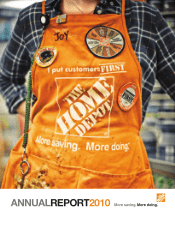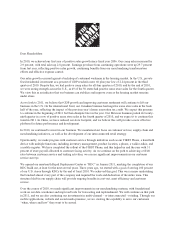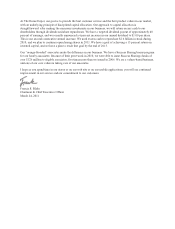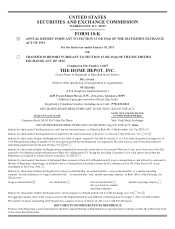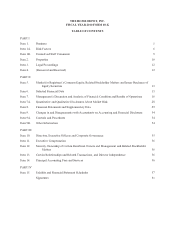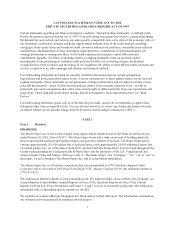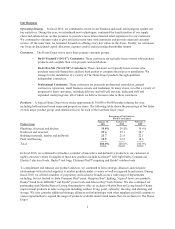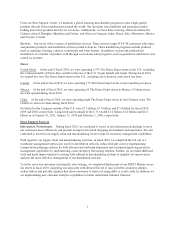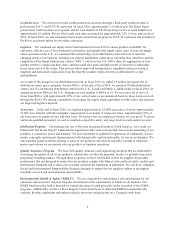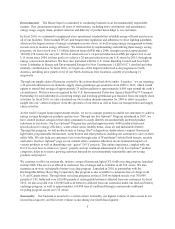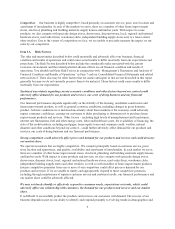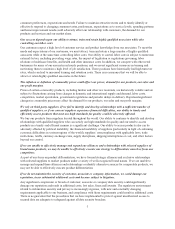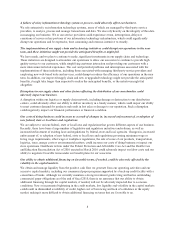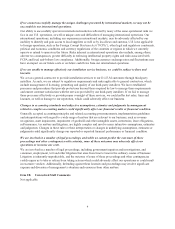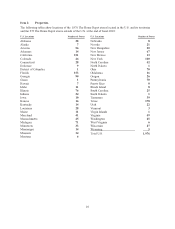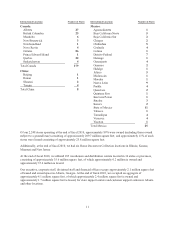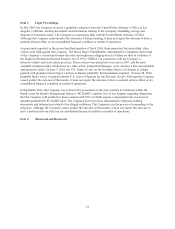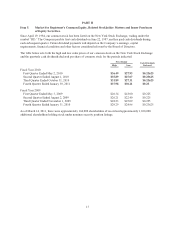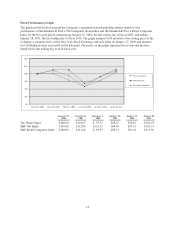Home Depot 2010 Annual Report Download - page 11
Download and view the complete annual report
Please find page 11 of the 2010 Home Depot annual report below. You can navigate through the pages in the report by either clicking on the pages listed below, or by using the keyword search tool below to find specific information within the annual report.Environmental. The Home Depot is committed to conducting business in an environmentally responsible
manner. This commitment impacts all areas of our business, including store construction and maintenance,
energy usage, supply chain, product selection and delivery of product knowledge to our customers.
In fiscal 2010, we continued to implement strict operational standards that establish energy efficient practices in
all of our facilities. These include HVAC unit temperature regulation and adherence to strict lighting schedules,
which are the largest sources of energy consumption in our stores, as well as using energy management systems
in each store to monitor energy efficiency. We estimate that by implementing and utilizing these energy saving
programs, we have saved over 3.5 billion kilowatt hours (kWh) since 2004, enough to power approximately
320,000 U.S. homes for one year. We have achieved over a 16 percent reduction in kWh per square foot in our
U.S. stores since 2004, and our goal is to achieve a 20 percent reduction in our U.S. stores by 2015, through our
energy conservation initiatives. We have also partnered with the U.S. Green Building Council and have built
seven Leadership in Energy and Environmental Design for New Construction (“LEED-NC”) certified and other
similarly certified stores. In fiscal 2010, we began one of the largest retailer host solar programs in North
America, installing solar panels on 62 of our North American store locations, capable of producing 21
megawatts.
Through our supply chain efficiencies created by the actions described above under “Logistics,” we are targeting
a 20 percent reduction in our domestic supply chain greenhouse gas emissions from 2008 to 2015, which would
equate to annual fuel savings of approximately 25 million gallons or approximately 8,000 trips around the earth’s
circumference. We have been recognized by the U.S. Environmental Protection Agency SmartWaySM Transport
Partnership for our leadership in conserving energy and lowering greenhouse gas emission from our supply chain
activities. In fiscal 2010, we also calculated our total carbon dioxide emissions for 2009 to allow us greater
insight into our “carbon footprint” from the operation of our stores as well as from our transportation and supply
chain activities.
As the world’s largest home improvement retailer, we are in a unique position to enable our customers to achieve
energy savings through our products and services. Through our Eco Options®Program introduced in 2007, we
have created product categories that allow consumers to easily identify environmentally preferred product
selections in our stores. Our Eco Options®Program has certified approximately 4,000 products that meet
specifications for energy efficiency, water conservation, healthy home, clean air and sustainable forestry.
Through this program, we sell products such as Energy Star®refrigerators, dishwashers, compact fluorescent
light bulbs, programmable thermostats, water heaters and other products, enabling our customers to save on their
utility bills. We also help our customers save water through sales of WaterSense®-labeled bath faucets, aerators
and toilets. Our Eco Options®page on our website offers consumer education on environmental impacts of
various products as well as identifying easy “green” D-I-Y projects. This online experience, coupled with our
D-I-Y in-store how-to clinics on “green” projects and our continual enhancement of our Eco Options®product
categories, helps us to meet a growing customer demand for environmentally responsible and cost-saving
products and projects.
We continue to offer our nationwide, in-store compact fluorescent light (CFL) bulb recycling program launched
in June 2008. This service is offered to customers free of charge and is available in all U.S. stores. We also
maintain an in-store rechargeable battery recycling program. Launched in 2001 in partnership with the
Rechargeable Battery Recycling Corporation, this program is also available to customers free of charge in all
U.S. and Canada stores. Through these recycling programs, in fiscal 2010 we helped recycle over 700,000
pounds of CFL bulbs and over 620,000 pounds of rechargeable batteries collected from our customers. In fiscal
2010, we also recycled over 120,000 lead acid batteries collected from our customers under our lead acid battery
exchange program, as well as approximately 160,000 tons of cardboard through a nationwide cardboard
recycling program across our U.S. stores.
Seasonality. Our business is seasonal to a certain extent. Generally, our highest volume of sales occurs in our
second fiscal quarter, and the lowest volume occurs during our fourth fiscal quarter.
5

